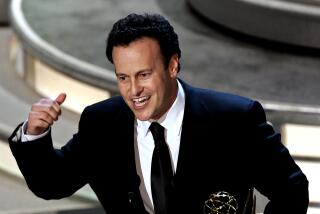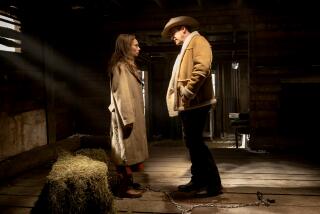It’s basic cable’s time to show off
- Share via
Rising from their status as television’s country mice, basic cable networks arrived this week at the semiannual meeting of the Television Critics Assn. in Pasadena in a critical glow, sporting recent Emmy nominations and increased ratings, signaling their new strength in the television family.
Critical honors and record-setting viewership figures indicate networks such as TNT, FX, USA and Discovery have found a cultural sweet spot between the often bland fare on networks and the boundary-pushing -- and some would say insider-driven -- content of pay cable. Unlike their competitors, basic cable networks are free to experiment (within regulatory limits, of course), and are available without the premium charged for pay cable.
Viewership for top basic cable shows often far exceed those for even the most popular pay cable offerings. TNT’s “The Closer” drew a record 9.2 million viewers for a second season episode; by comparison, such well-regarded HBO shows as “Entourage” and “Deadwood” get only a fraction of that number. And basic cable scored big in this month’s Emmy nominations, with TNT’s miniseries “Into the West” receiving more nods than any single show on network or cable.
Basic cable has been energized by a spurt of creative energy, from recognized artists such as Grammy-winning musician Andre Benjamin, who will compose original music for each episode of the Cartoon Network’s “Class of 3000” debuting in November. The basic cable networks are also attracting big name Hollywood talent: Ridley Scott will produce “The Company,” a six-part miniseries about the CIA for TNT in 2007; Kevin Costner and Hilary Swank are narrating Court TV’s 9/11 documentary, “On Native Soil,” premiering in August. Reality-show guru Mark Burnett and DreamWorks Television will produce “Devil’s Advocate” for the Sci-Fi Channel, which plans seven weekly original scripted drama series.
Programming on basic cable ranges from FX’s edgy firehouse drama “Rescue Me” to highly rated reality shows on Bravo such as “Project Runway” to USA Network’s tandem of crime comedies, the award-winning “Monk” and its new series “Pysch,” which fared well in its debut last week, to popular history, science, shopping and gardening shows.
“Popular taste is much more diverse than it used to be,” said Robert Sharenow, vice president of nonfiction and alternative programming at A&E;, which has been aggressively pursuing a younger audience with shows like “Criss Angel Mindfreak,” a series based on magic that nearly doubled its ratings in its second season and has been picked up for a third.
“There are very few shows out there now like ‘American Idol’ that everybody watches,” Sharenow added. “There are so many cultural choices it’s hard to build an enormous national consensus around music, film or a TV show. As a result, everything is a little bit niche.”
Unshackled by the networks’ demand for high and instant ratings success, basic cable can afford to experiment with individual interests from history and mystery to horse racing.
Gary Marsh, president of entertainment for Disney Channel Worldwide, said that its breakout hit this year, “High School Musical,” was not only the channel’s most successful original movie but had become a cultural phenomenon, generating a No. 1 album, a top-selling DVD and six Emmy nominations.
The Discovery Channel and the Learning Channel had “double digit” ratings increases, not to mention multiple Emmy nominations for its programs, including -- who would have guessed? -- “Deadliest Catch,” a show following Alaskan crab fishermen. It is Discovery’s highest rated series, averaging 2.6 million viewers in its second season.
The public’s interest in history has been growing and expanding the number of the History Channel’s viewers, said Carl Lindahl, the network’s vice president of historical programming. Producers of historical reenactments such as a special on the Mayflower in the fall also have raised the bar by taking advantage of new, sophisticated techniques, Lindahl said. So instead of using a Rand McNally map and a head shot of an expert, producers use more dramatized storytelling and computer graphics with animation to give viewers a feeling of the time and place.
Basic cable networks have worked with cable and satellite providers to improve content, according to Ryan O’Neal, president of the TV Guide Channel. That channel itself has evolved from a listings service to one that provides original programming such as “The Watercooler,” a talk show about television, to keep pace with the industry it covers.
More to Read
The complete guide to home viewing
Get Screen Gab for everything about the TV shows and streaming movies everyone’s talking about.
You may occasionally receive promotional content from the Los Angeles Times.






